GEARING UP FOR KINGS
Jamie Crawford provides some up-to-date advice on assembling tackle to chase our springtime yellowtail kings.
Kingfish would have to be the most exciting and explosive inshore species in southern Australia, hands down. I can’t think of any other temperate species that fight as hard as yellowtail kingfish. From the outset they are stubborn and determined to win their freedom – and many do. Their first run can be amazing, and if you manage to keep them clear of obstructions, the fight can turn into a dogged and drawn-out affair.
Even in deep water when most other species succumb to barotrauma, kingfish still keep their heads down and fight until the bitter end. They really are a spectacular sportfish, and right now we’re heading towards prime kingfish time here in SA, especially in our shallower gulf and bay waters.
It’s heart-in-mouth fishing when you see a pack of kings pushing through shallow water. But just seeing fish doesn’t guarantee a hook up. They can be an erratic species at times, and quite often you’ll spot fish, but will be left frustrated when they refuse to feed. Big kings certainly don’t come easily, and their fickle nature is part of their appeal and stature.
But they’re a fish certainly worth the effort.
The first – and most important step – when chasing kingfish is to select suitable tackle to handle a big one. So many kingfish are lost in the initial seconds after hookup; if you fail to keep a kingfish away from structure, they will bury you in a split second.
While some species require a delicate presentation and approach, big kings aren’t in this category. Most of the known grounds will have some form of structure nearby, including jetty pylons, channel markers, tyre reefs, oyster racks, boat moorings, limestone ledges, and so on. Some locations are obstruction free, but these locales are the exception rather than the norm.
If you are lucky enough to be fishing in an area free of obstructions, you can scale down and fish lighter; you’ll certainly get more hook-ups by doing so. But in most situations you’ll need to be heavy handed to keep fish away from nearby structure, and this means fishing with suitable tackle. You wouldn’t take a slug gun on an elephant hunt, so don’t take a PE2 outfit if you’re chasing kings in a harsh environment. I used to fish on the lighter side to maximise hookups, but nowadays I fish on the heavier side to stack the odds in my favor, with PE6 and PE8 dominating my gear used.
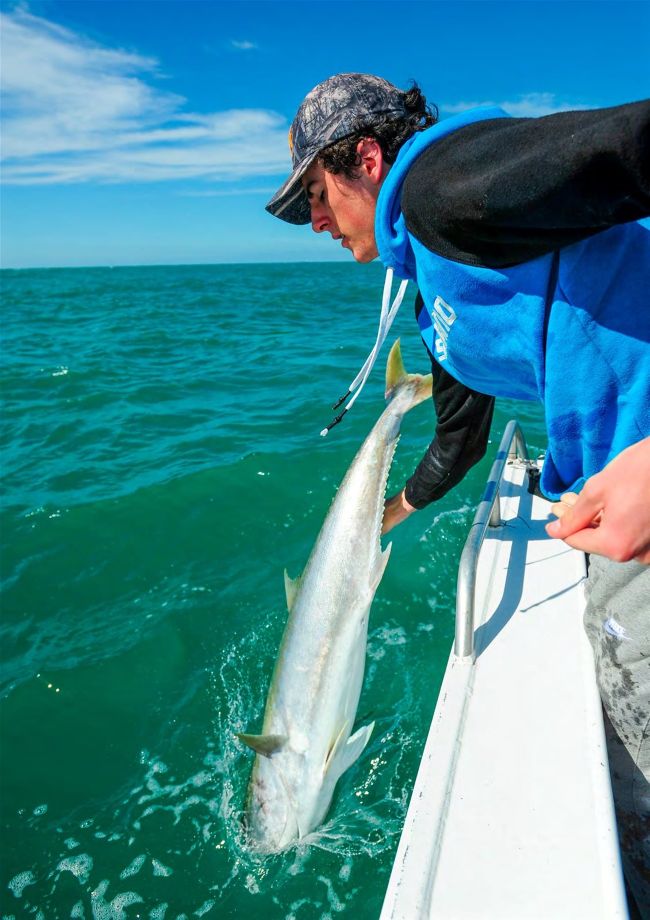
A decent king goes back to fight another day
We are spoilt for choice with quality tackle these days, with plenty of fantastic reels and offthe-shelf rods to pick from. Always aim to buy the best you can afford; big kings will sort out inferior tackle quicker than any other species in SA. While a cheaper outfit may handle a big fish or two, they don’t last the distance for multiple seasons of heavy tackle fishing. The wear and tear on cheaper reels while fishing heavy braid is brutal, and investing in a quality outfit will certainly pay for itself in the longer run.
The type of outfit you chose will ultimately depend on how you’ll be targeting kingfish. The most popular methods are pitching live baits at fish in shallow water, down rigging, dropping live or dead baits in deeper water, casting surface lures and jigging. Once you determine how you’ll be targeting your kings (and location will ultimately dictate this), you’ll be able to narrow down the tackle you need.
Of the above scenarios, I believe you can whittle the selection down to two outfits which should serve you well and cover most situations you’ll be faced with. The first is a PE5 casting outfit; this will allow you to pitch live baits, cast stick baits and poppers, and cast large soft plastics.
A rod of between 7’5” to 8’0” is a good length, allowing you pitch baits and lures a reasonable distance, which means you’ll be able to hang further back from a pack of fish to prevent spooking them with the boat. This extra rod length can be cumbersome in a small boat, and the fight from a bigger king will be drawn out, but the benefits of using a longer rod still outweigh the negatives.
The weight rating of the rod is a very important factor to consider. If the rod is too light, you’ll struggle to make casting distance with larger baits and lures, and the rod may lack the backbone needed to steer a big fish away from danger. With a slower taper and stiffer tip section you’ll find it easier to cast towards fish, however you’ll also run the risk of pulling hooks out of live baits on the cast if you’re too aggressive, so you’ll just need to be mindful of this.
I like the extra length of a rod when fighting a fish close to the boat, as it’s easier to steer a fish away from the outboard and transducers. Some good rods to consider include Shimano Grappler Type C, Daiwa Demon Blood, Wilson Venom, and if the budget allows, a high-end Japanese Carpenter rod such as the Sea Leopard or Monster Hunter. None of the above rods are a cheap option, but all of them are quality and will serve you well. Reels to suit these rods include Shimano Saragosa SW or Stradic SW or a Daiwa BG MQ or Saltist; each of these are well affordable. If you are in a position to invest more in the set-up, a Shimano Stella or Daiwa Saltiga are the cream of the crop. I would encourage you to stick with the tried and proven brands, or at the least to do some research of your own beforehand to validate the performance of the chosen reel.
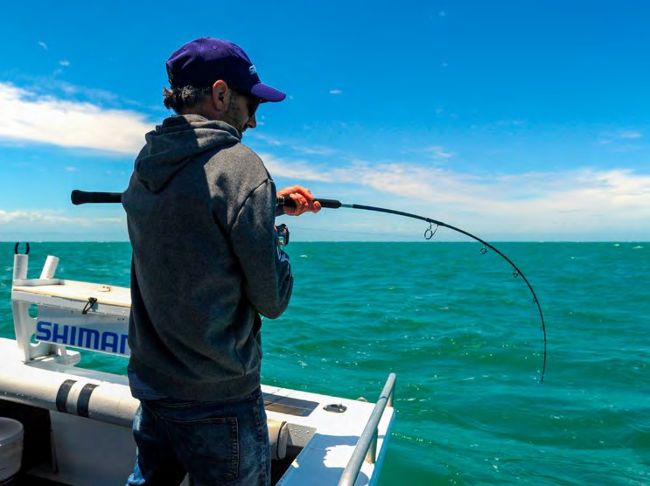
Longer rod are ideal for casting baits and lures at fish
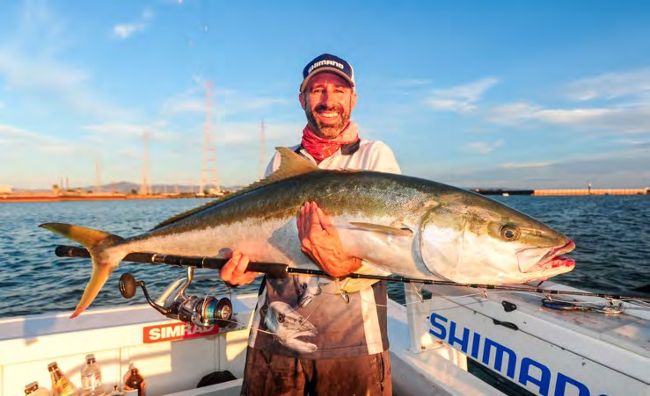
The author with a nice one from Port Augusta
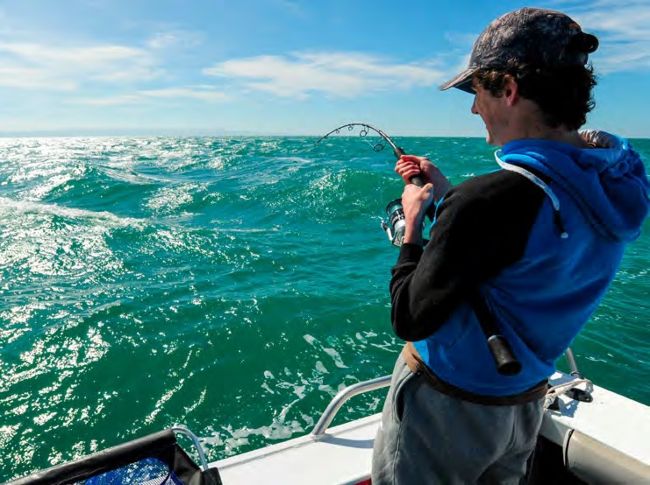
The Shimano Saragosa is a great threadline option
I would recommend fishing PE5 on this set up, so choose a size of reel suitable for fishing PE5 (50 to 65lb braid). Leader should be chosen depending on the location, but an 80lb leader would be the comfortable minimum, with 120lb being the upper end for this casting outfit.
The second outfit will cover you for dropping live baits on deeper reefs, down rigging baits around known haunts, plus vertically dropping live baits and dead baits against heavy structure such as the old power station wall at Port Augusta, channel markers and jetties etc. This is a heavy outfit designed to turn and keep the head of a big king away from structure and should give the angler the advantage in a close quarters fight.
This outfit consists of a shorter rod, designed to lock up and leverage the fish. A rod rated to fish with PE8 with the length of around 5’2” to 6’0” will allow the angler to put plenty of pressure onto a fish, and hopefully direct them away from danger. Some good rods include Wilson Venom and Nomad Design, along with Shimano Anthem SW and Terez, and Daiwa Saltiga J and Saltist Hyper heavy jig.
In the reel department, a slightly bigger option than the casting outfit is preferred, with a 14,000-20,000 spin reel capable of fishing 80-100lb braid giving the angler a real advantage. Overhead reels are also a good option when down rigging or livebaiting for kings. The Shimano Talica 16 is a popular reel for this application, especially in the 2-speed model. The Daiwa Saltiga LD and Catch Pro JGX3000 have also proven themselves as capable reels when matched to a suitable overhead rod for this style of fishing.
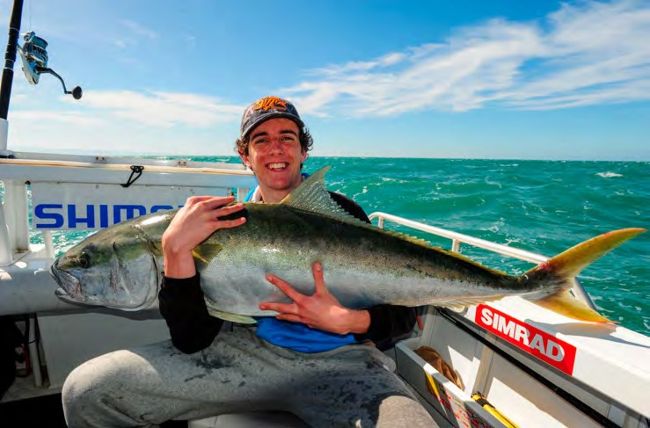
Tyler Crawford with a big SA king
In shallower settings, such as in our gulfs, line capacity isn’t a big issue. These fights are generally at close quarters and hence not a lot of line will leave the spool, unless you are away from danger. But these larger reels are capable of fishing some pretty heavy drag pressures; but that’s if the angler and terminal tackle can cope with the locked-up drag. Fishing with drag pressure over 15kg is not as easy as it sounds, and while the reel may be designed to cope with it, a lot of rods or terminal tackle simply aren’t up to the task.
I would recommend using 100lb leader in a fairly hard mono as a minimum on this set up, but even going up to 150lb in hard-to-fish environments is recommended. It’s important to practise and be competent tying a good braid to leader connection knot such as the FG or improved Albright. Otherwise, a double knot in conjunction with a wind-on leader will suffice, although for a casting outfit it’s better to run with a slimline knot such as the FG. The heavier leaders, say over 100lb, start to get pretty difficult to tie effective knots onto lures or rigs, and it’s becoming common practice to swage these heavier leaders with aluminium crimps.
The above PE8 outfit can also be used for jigging, but it will be a heavy jigging option and a bit cumbersome and one you wouldn’t want to jig with for a prolonged period. If you were going to be spending a lot of time jigging for kings, it’s worthwhile looking into a dedicated PE5 or PE6 jigging outfit.
Once this edition is released, we’ll be starting to see some packs of springtime kingfish moving into shallow regions of South Australia. We should see these kings frequenting the shallow margins of our state until around Christmas time, at which point they usually start to filter back out into the blue water. Here’s hoping 2024 will be a cracking season for kings here in SA.